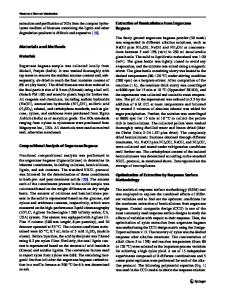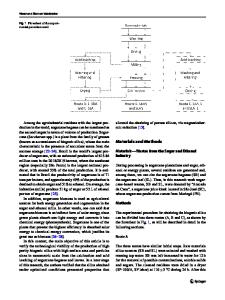Ultrafiltered biopulping strategy for the production of good quality pulp and paper from sugarcane bagasse
- PDF / 1,204,538 Bytes
- 9 Pages / 595.276 x 790.866 pts Page_size
- 76 Downloads / 320 Views
SHORT RESEARCH AND DISCUSSION ARTICLE
Ultrafiltered biopulping strategy for the production of good quality pulp and paper from sugarcane bagasse Libin Mathew Varghese 1 & Raksha Nagpal 1 & Avtar Singh 1 & Om Prakash Mishra 2 & Nishi Kant Bhardwaj 2 & Ritu Mahajan 1 Received: 10 March 2020 / Accepted: 4 October 2020 # Springer-Verlag GmbH Germany, part of Springer Nature 2020
Abstract This research was carried out with an objective to examine the efficacy of ultrafiltered xylano-pectinolytic enzymes in pulping of sugarcane bagasse. Maximum biopulping was achieved with enzyme dose of xylanase (175 IU / g bagasse) and pectinase (75 IU / g bagasse) at treatment period of 180 min. The temperature, pH, and bagasse to liquid ratio for biopulping experiments were kept constant at 55o C, 8.5, and 1:10 (g/ml), respectively. The ultrafiltered biopulping improved chemical pulping, resulted in 25.11%, 9.17% increase in brightness, unscreened pulp production and 11.81, 59.50, and 49.14% decrease in total solids, rejections. and kappa number, respectively. The bagasse biopulping also resulted in 15% decrease of alkali load to attain similar kappa number and optical properties as obtained under 100% alkali dosage. Ultrafiltered biopulped-unbleached samples showed significant increase in breaking length (13.55%), burst index (40.21%), tear index (19.04%), double fold (42.5%), Gurley porosity (28.21%) and viscosity (13.37%) in comparison with non-enzymatically treated control pulp samples. In comparison with non biotreatedbleached pulp samples, ultrafiltered biopulped-bleached samples also resulted in higher burst index (56.80%), breaking length (17.38%), double fold (39.58%), tear index (3.38%), viscosity (30.68%), and Gurley porosity (52.50%). This environmentally sustainable ultrafiltered biopulping approach for sugarcane bagasse has the potential to decrease the demand of chemicals, ultimately pollution along with enhance the quality of paper. Keywords Xylano-pectinolytic enzymes . Reducing sugars . Soda-anthraquinone pulping . Bleaching . Burst index . Breaking length . Double fold . Viscosity . Tear index
Introduction The market for pulp continues to grow rapidly across the globe. The boom in the paper production has shown no signs of slowing down, due to population explosion. It is expected that the demand for raw material would surpass the supply of pulp, from highly limited forest resources. This has led the
Libin Mathew Varghese and Raksha Nagpal contributed equally to this work. Responsible Editor: Ta Yeong Wu * Ritu Mahajan [email protected] 1
Department of Biotechnology, Kurukshetra University, Kurukshetra, India
2
Avantha Center for Industrial Research and Development, Paper Mill Campus, Yamuna Nagar, India
researchers to look for suitable additional non-woody material resources for pulp and paper manufacturing. In addition to search for new raw materials, biodegradation of lignocellulosics has been steadily stressed (Fahmy et al. 2017), and much focus has now been given to the development of new, eco-
Data Loading...











